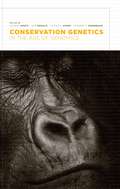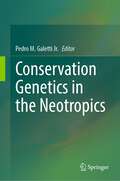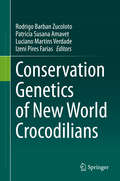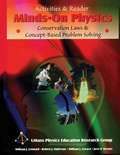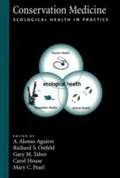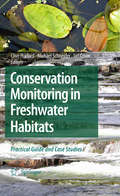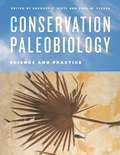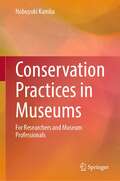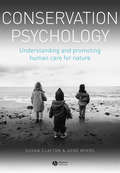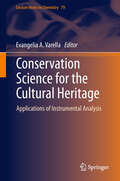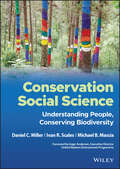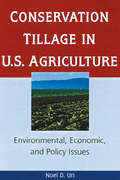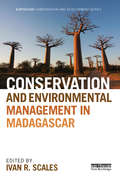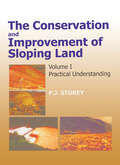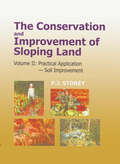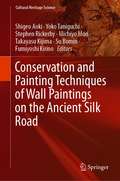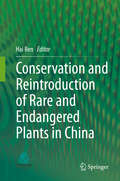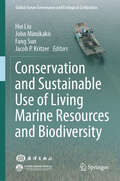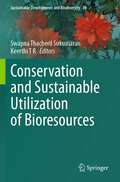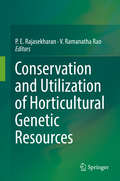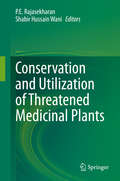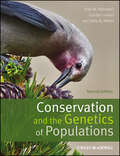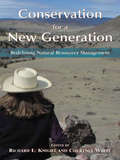- Table View
- List View
Conservation Genetics in the Age of Genomics
by Rob Desalle Oliver A. Ryder Howard C. Rosenbaum George AmatoGenome sequencing enables scientists to study genes over time and to test the genetic variability of any form of life, from bacteria to mammals. Thanks to advances in molecular genetics, scientists can now determine an animal's degree of inbreeding or compare genetic variation of a captive species to wild or natural populations. Mapping an organism's genetic makeup recasts such terms as biodiversity and species and enables the conservation of rare or threatened species, populations, and genes. By introducing a new paradigm for studying and preserving life at a variety of levels, genomics offers solutions to previously intractable problems in understanding the biology of complex organisms and creates new tools for preserving the patterns and processes of life on this planet. Featuring a number of high-profile researchers, this volume introduces the use of molecular genetics in conservation biology and provides a historical perspective on the opportunities and challenges presented by new technologies. It discusses zoo-, museum-, and herbarium-based biological collections, which have expanded over the past decade, and covers the promises and problems of genomic and reproductive technology. The collection concludes with the philosophical and legal issues of conservation genetics and their potential effects on public policy.
Conservation Genetics in the Age of Genomics (American Museum of Natural History, Center for Biodiversity Conservation, Series on Biodiversity)
by George Oliver A. Ryder Howard C. Rosenbaum Rob DeSalle Eds. AmatoGenome sequencing enables scientists to study genes over time and to test the genetic variability of any form of life, from bacteria to mammals. Thanks to advances in molecular genetics, scientists can now determine an animal's degree of inbreeding or compare genetic variation of a captive species to wild or natural populations. Mapping an organism's genetic makeup recasts such terms as biodiversity and species and enables the conservation of rare or threatened species, populations, and genes. By introducing a new paradigm for studying and preserving life at a variety of levels, genomics offers solutions to previously intractable problems in understanding the biology of complex organisms and creates new tools for preserving the patterns and processes of life on this planet. Featuring a number of high-profile researchers, this volume introduces the use of molecular genetics in conservation biology and provides a historical perspective on the opportunities and challenges presented by new technologies. It discusses zoo-, museum-, and herbarium-based biological collections, which have expanded over the past decade, and covers the promises and problems of genomic and reproductive technology. The collection concludes with the philosophical and legal issues of conservation genetics and their potential effects on public policy.
Conservation Genetics in the Neotropics
by Pedro M. GalettiThis book explores how genetics and the new technologies in genomics have been used for conservation of plants and animals in the Neotropics. It shows the new perspective for conservation genetics beyond the use of theoretical and methods in genetics at species level and presents how genetics and genomics can be used for assessing communities. Conservation genetics and genomics are presented as a helpful field of study for resolving taxonomic uncertainties and hidden biodiversity, understanding populations and extinction risk, genetic management, wildlife forensic genetics, assessing biology and molecular ecology, assessing communities, conservation genomics and the use of conservation biology and genetics in science learning, highlighting case studies in the Neotropics. Applications of conservation genetics for management or policy, decision making, planning, and implementation of conservation practice in the Neotropics are addressed across chapters. This book will interest to researchers and students in conservation genetics and biology conservation interested in the Neotropics. Stakeholders and decision makers in conservation biology may also find this book useful.
Conservation Genetics of New World Crocodilians
by Rodrigo Barban Zucoloto Patricia Susana Amavet Luciano Martins Verdade Izeni Pires FariasThis book aims to be a comprehensive review of the literature on the conservation genetics of the New World crocodilians, from the biological and demographical aspects of the living species to the application of molecular techniques for conservation purposes. It covers the current status of the molecular genetics applied to phylogenetics, phylogeography, diversity, kinship and mating system, and hybridization, as well its implications for decision making with regards to the conservation of these species at academic and governmental levels. This book can be used as a guide for graduate and undergraduate students to understand how conservation genetics techniques are carried out and how they can help preserve not only crocodilians but also other living species.
Conservation Laws and Concept-Based Problem-Solving (Minds on Physics)
by University of Massachusetts StaffThe activities in this book are designed to get you thinking about and doing physics in a way that is a lot closer to the way professional scientists think about and do science. You will learn by communicating your ideas with your teacher and with other students, and by trying to make sense of the ideas presented in the book.
Conservation Medicine: Ecological Health in Practice
by Carol House Richard Ostfeld Gary Tabor Mary Pearl A. AguirreConservation medicine is an emerging discipline, focussing on the intersection of ecosystem health, animal health, and human health. Work in the biomedical and veterinary sciences is now being folded into conservation biology; to explore the connections between animal and human health; trace the environmental sources of pathogens and pollutants; develop an understanding of the ecological causes of changes in human and animal health; and understand the consequences of diseases to populations and ecological communities.Conservation Medicinedefines this new discipline. It examines ecological health issues from various standpoints, including the emergence and resurgence of infectious disease agents; the increasing impacts of toxic chemicals and hazardous substances; and the health implications of habitat fragmentation and degradation and loss of biodiversity. It will provide a framework to examine the connections between the health of the planet and the health of all species and challenge practitioners and students in the health sciences and natural sciences to think about new, collaborative ways to address ecological health concerns.
Conservation Monitoring in Freshwater Habitats: A Practical Guide and Case Studies
by Michael Schneider Clive Hurford Ian CowxThe predicted changes to global weather patterns and increases in the human population will put unprecedented pressure on European freshwater habitats and the species that depend on them. Our success in conserving the ecological value of these habitats will depend greatly on carefully planned conservation management integrated with efficient and reliable monitoring. "Conservation Monitoring in Freshwater Habitats" focuses on the need to develop clear, site-specific, conservation management goals; something rarely considered in previous publications on freshwater monitoring. The early chapters explore the use of biological indicators for monitoring and provide practical guidance for developing and implementing efficient and reliable monitoring projects. The remainder of the book is dedicated to a series of carefully selected case studies illustrating best practice in both decision-making and application across a range of habitats and species. This timely book will provide a valuable reference for students and researchers in biological and environmental sciences, and for practitioners working in government departments, conservation organizations and ecological consultancies. It will be an essential resource for anyone working towards fulfilling the requirements of both the Water Framework Directive and the EC Habitats Directive.
Conservation Paleobiology: Science and Practice
by Gregory P. Dietl Karl W. FlessaIn conservation, perhaps no better example exists of the past informing the present than the return of the California condor to the Vermilion Cliffs of Arizona. Extinct in the region for nearly one hundred years, condors were successfully reintroduced starting in the 1990s in an effort informed by the fossil record—condor skeletal remains had been found in the area’s late-Pleistocene cave deposits. The potential benefits of applying such data to conservation initiatives are unquestionably great, yet integrating the relevant disciplines has proven challenging. Conservation Paleobiology gathers a remarkable array of scientists—from Jeremy B. C. Jackson to Geerat J. Vermeij—to provide an authoritative overview of how paleobiology can inform both the management of threatened species and larger conservation decisions. Studying endangered species is difficult. They are by definition rare, some exist only in captivity, and for those still in their native habitats any experimentation can potentially have a negative effect on survival. Moreover, a lack of long-term data makes it challenging to anticipate biotic responses to environmental conditions that are outside of our immediate experience. But in the fossil and prefossil records—from natural accumulations such as reefs, shell beds, and caves to human-made deposits like kitchen middens and archaeological sites—enlightening parallels to the Anthropocene can be found that might serve as a primer for present-day predicaments. Offering both deep-time and near-time perspectives and exploring a range of ecological and evolutionary dynamics and taxa from terrestrial as well as aquatic habitats, Conservation Paleobiology is a sterling demonstration of how the past can be used to manage for the future, giving new hope for the creation and implementation of successful conservation programs.
Conservation Practices in Museums: For Researchers and Museum Professionals
by Nobuyuki KambaThe author introduces conservation science and management of cultural heritages in museums. In particular, a comprehensive conservation study and practical techniques are described. Aspects such as examination and diagnosis of cultural heritage by scientific data recording of humidity, luminosity, intensity of vibration and shock, among others, are introduced. Preventive and remedial conservation with X-ray imaging and X-ray fluorescence and other risk-control methods are also explained. The author provides basic theories based on a scientific view for the methods introduced in this book. They can be compared with those used at other museums, and readers can employ them to adapt and improve their methods. Today, maintaining smooth internal communication is key for scientists and curators with different academic backgrounds and from different departments working together on conservation projects at the museum.The author addresses the current global trend of preserving rather than repairing cultural heritage at museums and emphasizes its importance.
Conservation Psychology: Understanding and Promoting Human Care for Nature (Oxford Library Of Psychology Ser.)
by Susan Clayton Gene MyersThis textbook introduces the reader to the new and emerging field of Conservation Psychology, which explores connections between the study of human behavior and the achievement of conservation goals. People are often cast as villains in the story of environmental degradation, seen primarily as a threat to healthy ecosystems and an obstacle to conservation. But humans are inseparable from natural ecosystems. Understanding how people think about, experience, and interact with nature is crucial for promoting environmental sustainability as well as human well-being. The book first summarizes theory and research on human cognitive, emotional, and behavioral responses to nature and goes on to review research on people's experience of nature in wild, managed, and urban settings. Finally, it examines ways to encourage conservation-oriented behavior at both individual and societal levels. Throughout, the authors integrate a wide body of published literature to demonstrate how and why psychology is relevant to promoting a more sustainable relationship between humans and nature.
Conservation Science for the Cultural Heritage: Applications of Instrumental Analysis (Lecture Notes in Chemistry #79)
by Evangelia A. VarellaConservation Science is a rather innovative application of instrumental analysis with steadily increasing importance. Although the first attempts for preserving material from the cultural heritage on a scientific basis are found in the 19th century pioneer chemistry years, only the use of sophisticated physicochemical techniques results in effective identification and deterioration studies of monuments and objects, and in reliable intervention procedures. This volume allows to gain solid knowledge and improved skills on the ways separation schemes and diagnostic methodologies are applied in the safeguarding and authentication of tangible works of art; as well as on the modes of implementing novel safeguarding practices built on well-established principles - such as the use of laser in the decontamination of objects. All techniques are covered at a state-of-the-art level; while selected applications permit addressing major groups of materials and artefacts. Conservation Science is nowadays taught at master's level in all developed countries, and museum laboratories increasingly adopt scientific approaches in their restoration initiatives. The book is intended as a valuable tool for students and professionals active in these frames. In addition, it provides an indispensable manual for participants in the specialized intensive courses, which are systematically offered by the authors under the auspices of the relevant European network.
Conservation Social Science: Understanding People, Conserving Biodiversity
by Ivan R. Scales Daniel C Miller Michael B. MasciaConservation Social Science Groundbreaking book that examines the essential contribution of the social sciences to understanding and conserving biodiversity across the globe Authored by leading scholars at the nexus of social science and biodiversity conservation, Conservation Social Science addresses the growing realization that biodiversity conservation is, at heart, a social phenomenon. Threats to biological diversity are influenced by a wide range of political, economic and cultural factors. The conservation of biodiversity is conceived and carried out by people. Biodiversity conservation is a manifestation of human beliefs and values. Choices about which species and habitats to conserve, how to prioritize efforts, and how to conserve them are inherently social − with consequences not just for wildlife but also human lives and livelihoods. Key topics covered in this thought-provoking text include: An introduction to key social science disciplines and how each field specifically relates to biodiversity conservation How to make social sciences an integral part of conservation strategies and initiatives How social science theories and analytic approaches can explain and help predict patterns of human behavior How biodiversity conservation as a ubiquitous societal phenomenon can provide insights into human society in general Conservation Social Science is an essential, one-of-a-kind survey of novel approaches to explaining and fostering more effective, just, and enduring conservation of biodiversity. It is academically rigorous and comprehensive in scope, yet sufficiently nontechnical and concise to be accessible to a global audience of students, faculty, and environmental professionals and policymakers.
Conservation Tillage in U.S. Agriculture: Environmental, Economic, and Policy Issues
by Noel UriDiscover farming techniques that will decrease soil erosion and costs!Soil erosion from U.S. croplands has long been recognized as a national problem. Conservation Tillage in U.S. Agriculture: Environmental, Economic, and Policy Issues is the first ever complete study of the costs and benefits of using conservation tillage to prevent soil erosion. Designed for professionals working in the areas of soil science, agronomy, economics, environmental studies, and agriculture, this complete study covers everything from machinery and trends in conservation tillage to its adoption to use in regions of the United States.With this in-depth manual, you will examine different types of tillage and the many benefits this practice can ensure, such as improving water quality, increasing organic matter in your soil, sequestering carbon, and providing habitat and food for wildlife. Covering the economic, environmental, and policy issues of this practice, Conservation Tillage in U.S. Agriculture features: the history of conservation tillage case studies on costs and benefits of differing conservation tillage practices with various crops tables and graphs of trends, and case studies concerning the use of different farming methods U.S. Department of Agriculture soil conservation policies how to prevent soil erosion without harming the environment factors affecting conservation tillage, adoption, and use for crops such as peanuts, potatoes, beets, tobacco, and vegetables. With the help of this book, you will measure the benefits and costs of conservation tillage based on profitability and environmental impact and explore the positive and negative environmental consequences that may involve air, land, water, and/or the health and ecological status of wildlife. Conservation Tillage in U.S. Agriculture is a timely and informative look at conservation tillage practices that will help you improve residue management and create better conditions for wildlife and the environment.
Conservation and Environmental Management in Madagascar (Earthscan Conservation and Development)
by Ivan R. ScalesMadagascar is one of the most biologically diverse places on the planet, the result of 160 million years of isolation from the African mainland. More than 80% of its species are not found anywhere else on Earth. However, this highly diverse flora and fauna is threatened by habitat loss and fragmentation, and the island has been classified as one of the world’s highest conservation priorities. Drawing on insights from geography, anthropology, sustainable development, political science and ecology, this book provides a comprehensive assessment of the status of conservation and environmental management in Madagascar. It describes how conservation organisations have been experimenting with new forms of protected areas, community-based resource management, ecotourism, and payments for ecosystem services. But the country must also deal with pressing human needs. The problems of poverty, development, environmental justice, natural resource use and biodiversity conservation are shown to be interlinked in complex ways. Authors address key questions, such as who are the winners and losers in attempts to conserve biodiversity? And what are the implications of new forms of conservation for rural livelihoods and environmental justice?
Conservation and Improvement of Sloping Lands, Vol. 1: Practical Understanding (Conservation and Improvement of Sloping Lands)
by P J StoreyThis book offers a positive response to the challenge to both conserve and improve the soil and water situation particularly on sloping lands. It explains how even apparently useless land can be brought into production using locally available resources.
Conservation and Improvement of Sloping Lands, Vol. 2: Practical Application - Soil Improvement (Conservation and Improvement of Sloping Lands)
by P J StoreyThis book looks at how soil develops, what makes fertile soil, and what spoils soil. Recognizing and treating mineral deficiencies, it presents the ways to improve soil texture and to improve the soil management.
Conservation and Painting Techniques of Wall Paintings on the Ancient Silk Road (Cultural Heritage Science)
by Stephen Rickerby Shigeo Aoki Yoko Taniguchi Michiyo Mori Takayasu Kijima Su Bomin Fumiyoshi KirinoThis book presents recent research on ancient Silk Road wall paintings, providing an up-to-date analysis of their coloring materials and techniques, and of developments in efforts to preserve them.The destruction of the Bamiyan Buddhas in 2001 encouraged international collaboration between conservation research institutes to study and protect the Silk Road’s painted heritage. The collaborations led to exciting new discoveries of the rich materials used in wall painting, including diverse pigments and colorants, and various types of organic binding media. In addition, comparative research across the region revealed shared painting practices that indicate the sophisticated exchange of technologies and ideas. In parallel with these advances in technical understanding, greater awareness and sensitivity has been fostered in endeavors to preserve this fragile heritage. The book offers insights obtained from conservation projects and ongoing research, that encompass the geographical regions and periods related to the Silk Road, including from Japan, China, Korea, India and Afghanistan, and countries of the Eastern Mediterranean region. It also discusses the current issues and future challenges in the field. Featuring concise chapters, the book is a valuable resource for students and professionals in the field of cultural heritage preservation, as well as those who are not familiar with the fascinating topic of Silk Road wall painting research.
Conservation and Reintroduction of Rare and Endangered Plants in China
by Hai RenThe book offers a comprehensive review of the advances in conservation and the reintroduction of rare and endangered plants in China. It systematically discusses plant diversity, in situ and ex situ protection and plant reintroduction in China, including the reintroduction species list and orchid plant reintroduction up to November 2019. A useful reference resource for students, instructors and scientific researchers in the field of wild plant protection, botany, biodiversity protection, and natural land protection and management, the book also provides valuable insights for government departments involved in plant management.
Conservation and Sustainable Use of Living Marine Resources and Biodiversity (Global Ocean Governance and Ecological Civilization)
by Hui Liu John Mimikakis Fang Sun Jacob P. KritzerThis book is based on the Special Policy Study on Global Ocean Governance and Ecological Civilization commissioned by the China Council for International Cooperation on Environment and Development (CCICED). The book scrutinizes China's successful experiences, approaches and needs in building an ecological civilization in management and utilization of living marine resources. The book provides a global landscape analysis of living marine resources, outlining the current status, existing management approaches, challenges, and needs. With the growing threats posed by climate change, the book includes a chapter devoted to the effects of climate on marine species. After highlighting and presenting key international cases from around the world, the book makes several recommendations to support China's next efforts to create an ecological civilization of living marine resources at home and abroad.
Conservation and Sustainable Utilization of Bioresources (Sustainable Development and Biodiversity)
by Swapna Thacheril Sukumaran Keerthi T RThis book brings together chapters related to sustainable utilization of biological resources, including in situ and ex situ conservation of rare, endangered, and threatened plants. The title also gives a special emphasis on marine sponges and mangrove ecosystems, which are two important untapped potential resources of the marine ecosystem and play a key role in maintaining the marine ecosystem. There is an urgent need for the conservation, exploration and utilization of bioresources for the growth and survival of human beings. Due to the significant reduction in biological resources, many countries are developing strategic action plans for the conservation and sustainable use of biological resources. That is where this book fills the gap by discussing the significant development of new products and methodologies for sustainable utilization of these resources. This book also unveils a world of novel bioactive molecules from medicinal plants and the marine ecosystem and explains how drug design pipelines can advance modern drug development. The target audiences for this book include biodiversity researchers who are working on technology and bioresource management issues and faculty and students in the environment research areas and Biodiversity conservation.
Conservation and Utilization of Horticultural Genetic Resources
by P. E. Rajasekharan V. Ramanatha RaoThe conservation of crop genetic resources is one of the important elements in efforts to sustainably increase agricultural production in low-income countries, and to guarantee long-term food security, especially for the low-income population groups in these countries. Horticultural crops, as high-value crops, have an important role to play in revitalizing rural economies and can add significantly to national economies. Moreover, horticulture provides more than twice the number of jobs compared to traditional cereal crop production, and the shifting of conventional agriculture towards high-value horticulture has increased employment opportunities in developing countries. To exploit this potential, researchers need a vast array of horticultural genetic resources and information on new traits. Horticultural crops, which are only a part of PGRFA (Plant Genetic Resources for Food and Agriculture), are characterized by a wide and varied range of species. In fact, there are five major horticultural crop groups: fruit and nut crops, vegetables, food legumes, roots and tubers, and lastly the ornamental and medicinal group. In this context, the present book provides a comprehensive overview of the current state of conservation and utilization of horticultural genetic resources, addressing contemporary approaches to conservation in connection with different technologies, including biotechnological approaches as practised in India and in some cases, globally. It includes a brief chapter on the unique nature of horticultural genetic resources, providing a rationale for viewing them as being distinct from field crop genetic resources. Subsequent chapters share insights on protocols for the conservation of selected horticultural crops ex situ, and focus on the increased need to complement these efforts with in situ conservation approaches. Geospatial tools are also briefly described, emphasizing their utility with regard to mapping and managing resources. The book also explores the wild gene pool in horticulture crops; discusses legal aspects related to horticultural genetic resources and biotechnological aspects; and describes the key aspects of sustainable management and replenishment. Given its scope, the book offers a valuable resource for all horticulturists, graduate students, researchers, policymakers, conservationists, and NGOs engaged in horticulture in particular and biodiversity in general.
Conservation and Utilization of Threatened Medicinal Plants
by Shabir Hussain Wani P. E. RajasekharanMedicinal plants are globally valuable sources of herbal products. Plant-based remedies have been used for centuries and have had no alternative in the western medicine repertoire, while others and their bioactive derivatives are in high demand and have been the central focus of biomedical research. As Medicinal plants move from fringe to mainstream with a greater number of individuals seeking treatments free of side effects, considerable attention has been paid to utilize plant-based products for the prevention and cure of human diseases. An unintended consequence of this increased demand, however, is that the existence of many medicinal plants is now threatened, due to their small population size, narrow distribution area, habitat specificity, and destructive mode of harvesting. In addition, climate change, habitat loss and genetic drift have further endangered these unique species. Although extensive research has been carried out on medicinal and aromatic plants, there is relatively little information available on their global distribution patterns, conservation and the associated laws prevailing.This book reviews the current status of threatened medicinal plants in light of increased surge in the demand for herbal medicine. It brings together chapters on both wild (non-cultivated) and domestic (cultivated) species having therapeutic values. Thematically, conventional and contemporary approaches to conservation of such threatened medicinal plants with commercial feasibility are presented. The topics of interest include, but not limited to, biotechnology, sustainable development, in situ and ex situ conservation, and even the relevance of IPR on threatened medicinal plants. We believe this book is useful to horticulturists, botanists, policy makers, conservationists, NGOs and researchers in the academia and the industry sectors.
Conservation and the Genetics of Populations
by Fred W. Allendorf Gordon H. Luikart Sally N. AitkenLoss of biodiversity is among the greatest problems facing the world today. Conservation and the Genetics of Populations gives a comprehensive overview of the essential background, concepts, and tools needed to understand how genetic information can be used to conserve species threatened with extinction, and to manage species of ecological or commercial importance. New molecular techniques, statistical methods, and computer programs, genetic principles, and methods are becoming increasingly useful in the conservation of biological diversity. Using a balance of data and theory, coupled with basic and applied research examples, this book examines genetic and phenotypic variation in natural populations, the principles and mechanisms of evolutionary change, the interpretation of genetic data from natural populations, and how these can be applied to conservation. The book includes examples from plants, animals, and microbes in wild and captive populations. This second edition contains new chapters on Climate Change and Exploited Populations as well as new sections on genomics, genetic monitoring, emerging diseases, metagenomics, and more. One-third of the references in this edition were published after the first edition. Each of the 22 chapters and the statistical appendix have a Guest Box written by an expert in that particular topic (including James Crow, Louis Bernatchez, Loren Rieseberg, Rick Shine, and Lisette Waits). This book is essential for advanced undergraduate and graduate students of conservation genetics, natural resource management, and conservation biology, as well as professional conservation biologists working for wildlife and habitat management agencies. Additional resources for this book can be found at: www.wiley.com/go/allendorf/populations.
Conservation for a New Generation: Redefining Natural Resources Management
by Courtney White Richard L. KnightIn hundreds of watersheds and communities across the United States, conservation is being reinvented and invigorated by collaborative efforts between federal, state, and local governments working with nongovernmental organizations and private landowners, and fueled by economic incentives, to promote both healthy natural communities and healthy human communities. Conservation for a New Generation captures those efforts with chapters that explain the new landscape of conservation along with case studies that illustrate these new approaches. The book brings together leading voices in the field of environmental conservation--Lynne Sherrod, Curt Meine, Daniel Kemmis, Luther Propst, Jodi Hilty, Peter Forbes, and many others--to offer fourteen chapters and twelve case studies that * demonstrate the benefits of government agencies partnering with diverse stakeholders; * explore how natural resources management is evolving; * discuss emerging practices for conservation, including conservation planning, ecological restoration, valuing ecosystem services, and using economic incentives; * promote cooperation on natural resources issues that have in the past been divisive. Throughout, contributors focus on the fundamental truth that unites human and land communities: as one prospers, so does the other; as one declines, so too will the other. The book illustrates how natural resources management that emphasizes building strong relationships results in outcomes that are beneficial to both people and land.
